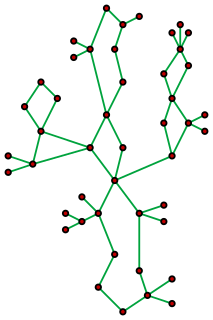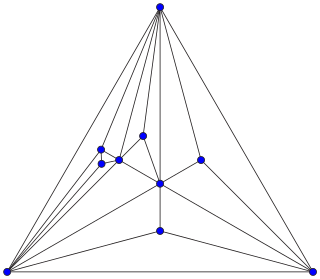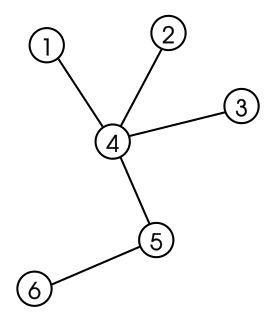In graph theory, a branch of mathematics, the (binary) cycle space of an undirected graph is the set of its Eulerian subgraphs.

In graph theory, graph coloring is a special case of graph labeling; it is an assignment of labels traditionally called "colors" to elements of a graph subject to certain constraints. In its simplest form, it is a way of coloring the vertices of a graph such that no two adjacent vertices are of the same color; this is called a vertex coloring. Similarly, an edge coloring assigns a color to each edge so that no two adjacent edges are of the same color, and a face coloring of a planar graph assigns a color to each face or region so that no two faces that share a boundary have the same color.
In graph theory, Mac Lane's planarity criterion is a characterisation of planar graphs in terms of their cycle spaces, named after Saunders Mac Lane, who published it in 1937. It states that a finite undirected graph is planar if and only if the cycle space of the graph has a cycle basis in which each edge of the graph participates in at most two basis vectors.
In the mathematical field of graph theory, the Laplacian matrix, sometimes called admittance matrix, Kirchhoff matrix or discrete Laplacian, is a matrix representation of a graph. The Laplacian matrix can be used to find many useful properties of a graph. Together with Kirchhoff's theorem, it can be used to calculate the number of spanning trees for a given graph. The sparsest cut of a graph can be approximated through the second smallest eigenvalue of its Laplacian by Cheeger's inequality. It can also be used to construct low dimensional embeddings, which can be useful for a variety of machine learning applications.
In graph theory, a clustering coefficient is a measure of the degree to which nodes in a graph tend to cluster together. Evidence suggests that in most real-world networks, and in particular social networks, nodes tend to create tightly knit groups characterised by a relatively high density of ties; this likelihood tends to be greater than the average probability of a tie randomly established between two nodes.

In graph theory, a maximal independent set (MIS) or maximal stable set is an independent set that is not a subset of any other independent set. In other words, there is no vertex outside the independent set that may join it because it is maximal with respect to the independent set property.
In combinatorics, the Eulerian numberA(n, m), is the number of permutations of the numbers 1 to n in which exactly m elements are greater than the previous element. They are the coefficients of the Eulerian polynomials:

The Barabási–Albert (BA) model is an algorithm for generating random scale-free networks using a preferential attachment mechanism. Several natural and human-made systems, including the Internet, the world wide web, citation networks, and some social networks are thought to be approximately scale-free and certainly contain few nodes with unusually high degree as compared to the other nodes of the network. The BA model tries to explain the existence of such nodes in real networks. The algorithm is named for its inventors Albert-László Barabási and Réka Albert and is a special case of a more general model called Price's model.

In graph theory, a cactus is a connected graph in which any two simple cycles have at most one vertex in common. Equivalently, it is a connected graph in which every edge belongs to at most one simple cycle, or in which every block is an edge or a cycle.

Network science is an academic field which studies complex networks such as telecommunication networks, computer networks, biological networks, cognitive and semantic networks, and social networks, considering distinct elements or actors represented by nodes and the connections between the elements or actors as links. The field draws on theories and methods including graph theory from mathematics, statistical mechanics from physics, data mining and information visualization from computer science, inferential modeling from statistics, and social structure from sociology. The United States National Research Council defines network science as "the study of network representations of physical, biological, and social phenomena leading to predictive models of these phenomena."

Modularity is one measure of the structure of networks or graphs. It was designed to measure the strength of division of a network into modules. Networks with high modularity have dense connections between the nodes within modules but sparse connections between nodes in different modules. Modularity is often used in optimization methods for detecting community structure in networks. However, it has been shown that modularity suffers a resolution limit and, therefore, it is unable to detect small communities. Biological networks, including animal brains, exhibit a high degree of modularity.

In combinatorial mathematics, an Apollonian network is an undirected graph formed by a process of recursively subdividing a triangle into three smaller triangles. Apollonian networks may equivalently be defined as the planar 3-trees, the maximal planar chordal graphs, the uniquely 4-colorable planar graphs, and the graphs of stacked polytopes. They are named after Apollonius of Perga, who studied a related circle-packing construction.
In mathematics, specifically group theory, a descendant tree is a hierarchical structure for visualizing parent-descendant relations between isomorphism classes of finite groups of prime power order , for a fixed prime number and varying integer exponents . Such groups are briefly called finitep-groups. The vertices of a descendant tree are isomorphism classes of finite p-groups.

The structural cut-off is a concept in network science which imposes a degree cut-off in the degree distribution of a finite size network due to structural limitations. Networks with vertices with degree higher than the structural cut-off will display structural disassortativity.

In network science, the efficiency of a network is a measure of how efficiently it exchanges information. The concept of efficiency can be applied to both local and global scales in a network. On a global scale, efficiency quantifies the exchange of information across the whole network where information is concurrently exchanged. The local efficiency quantifies a network's resistance to failure on a small scale. That is the local efficiency of a node characterizes how well information is exchanged by its neighbors when it is removed.
In the mathematical field of graph theory, a prism graph is a graph that has one of the prisms as its skeleton.

In network science, the configuration model is a method for generating random networks from given degree sequence. It is widely used as a reference model for real-life social networks, because it allows the user to incorporate arbitrary degree distributions.

Maximum-entropy random graph models are random graph models used to study complex networks subject to the principle of maximum entropy under a set of structural constraints , which may be global, distributional, or local.











